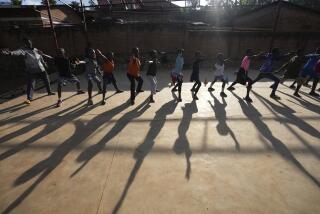Tsunami Torments Minds After Breaking Bodies
- Share via
COLOMBO, Sri Lanka — It was a beautiful Sunday morning, with almost no wind, when a crowded train called the Queen of the Sea pulled out of Colombo station on schedule at 7:40 and headed down the coast.
Rumesh Priyankara was excited about his day in the country with his grandmother. A little more than an hour into the trip, however, the 14-year-old’s idyll ended.
Now he can’t stop remembering the other passengers’ screams that the sea was coming. The massive wave that knocked over the train’s coaches like toys. The watery grave that swallowed his grandmother and 800 other people on board.
The physical signs of Sunday’s deadly tsunami are everywhere here. Less visible, but potentially longer lasting, are the mental wounds. And mental health experts say unique characteristics of the catastrophe are compounding the psychological recovery process.
The fact that it struck out of the blue on a beautiful morning during a holiday period, they say, sends an underlying message that even core beliefs -- that sea and land are distinct, that entire communities don’t just disappear in seconds -- can’t be taken for granted.
“We’re seeing a lot of very stressed people in hospitals, given all they’ve suffered, including many in delirium,” said Hemamali Perera, senior lecturer in psychological medicine with the Medical Faculty of Colombo. “We’re seeing deep grief, distress, people unable to talk, although it’s way too early to see the full impact.”
Aid workers, civic groups and mental health experts say these costs will be borne over years, even decades.
“On the 26th, there wasn’t even any wind, no warning whatsoever,” said Lalith Samantha Dias, 35, a fisherman, huddling with a dozen neighbors near a tiny Hindu shrine outside Colombo, where they’d retreated after their houses were destroyed by the wave. “It’s just so shocking. Our children are still rattled, unable to sleep.”
For Sri Lanka in particular, there’s also the sheer scale of the disaster. With 20,000 dead and 1 million displaced out of a relatively small population of 20 million, almost everyone knows people who have been lost or had their lives turned upside down.
“In our office alone, someone’s friend went for a day at the beach and disappeared,” said Sithmini Perera, the Sri Lankan communications director for World Vision, a civic group.
“My colleague’s family was washed away. On the east coast, an estimated 100 children are gone. How do you deal with this?”
Also jarring is the way people died. Whereas most disasters leave their dead behind, this one stole away with many of its victims. Limited refrigeration and the high number of fatalities mean that even many recovered bodies are being buried before loved ones can see them. In a culture in which funerals often involve displaying the body for two or three days, families are being denied the closure needed to cope.
The difficulties Sri Lankans face in trying to recover mentally started surfacing almost as soon as the water receded.
Jerome Kerr-Jarrett, a 25-year-old British tourist who was swept into the sea from his cabana, headed for the hills, bleeding and exhausted after narrowly escaping death. Once at a safe elevation, he tried to get the hundreds of people gathered to start thinking about food, shelter and basic survival, he said. For hours and in some cases days, however, many people just sat there dazed.
“We tried to get them moving, but it was impossible to get through to people,” Kerr-Jarrett said. “Most had just shut down.”
In fact, both sets of behaviors are coping mechanisms, experts say. Though Kerr-Jarrett’s quick response may have been a lifesaver, throwing yourself into a task immediately after being traumatized is a way of dealing with the shock and pain of the experience. By staying busy, you’re delaying thinking about what you’ve been through until a time when you can better process it.
The 300 workers of the Sri Lankan Red Cross are seeing early signs of trauma that, if not treated, can turn into full-blown post-traumatic stress disorder. The selective nature of this tragedy, with coastal communities devastated but the capital and inland areas unscathed, also may prolong the adjustment process.
“People who feel that others are enjoying a better life while they’ve had everything washed away lose hope and no longer know how to live in this world,” said Rangith Mudalige, the organization’s director-general. “There’s no cure, really. The only way is to assist them with the basics, to hopefully ease them back toward a normal life.”
Sri Lanka’s culture adds complications of its own. Although it’s gradually changing, driven in large part by the war between the government and Tamil Tiger separatists, the island nation traditionally has stigmatized those with mental problems, even blaming bad karma or past misdeeds.
But because the symptoms arising now were brought on by a natural disaster that struck the entire community, the onus on the individual is lighter.
On the other hand, Sri Lanka’s strong communal culture may help the healing. When someone falls ill or dies, traditionally the entire village pulls together.
People often take turns spending 24 hours a day, even for weeks, with the grieving to ward off loneliness and depression.
“I’d say 90% of the response you’re seeing now is collective activity,” said Siri Hettige, a sociology professor at the University of Colombo. “At my university we put out an appeal, and the response from students was overwhelming. The government is not reliable as a source of support, as in many developing countries, so the community is preeminent.”
Another common response to great trauma is to ascribe blame, and here tradition may also play a role, Hettige said. News outlets have diagramed the earthquake, detailing how the tsunami was generated and why Sri Lanka was caught unawares. But a traditional belief holds that such misfortune signals God’s fury with the country and its leaders.
“The Mahawansa,” one of the nation’s seminal books of history and tradition, details a wall of water flooding the land 2,000 years ago. The king was forced to sacrifice his daughter to regain divine favor by sending her out to sea in a ship.
Hettige predicted that people would start revisiting this ancient tale as the echo of traditional beliefs resurfaced, particularly in the less sophisticated rural areas where most of the devastation occurred.
Rumesh, the boy on the train, sat on a white plastic chair with his aunts, uncles, sleeping grandfather and other family members and described the horror he’d been through. On the wall of the motorcycle repair shop where they gathered were posters of his dead grandmother, a small memorial to the woman they all loved.
“My mother is overseas working, so my grandmother has been my mother,” he said. “She loved us. I miss her terribly. I can’t describe the loss.”
His grandfather slept under his dead wife’s picture. He hadn’t spoken much since the disaster.
Rumesh said he didn’t know how he survived when so many others died. “I guess it was just my fate,” he said.
“We’re all having a hard time,” added his father, U. Ranjith Fernando, a 40-year-old bus driver. “This sort of thing shouldn’t even happen to your enemies.”
More to Read
Sign up for Essential California
The most important California stories and recommendations in your inbox every morning.
You may occasionally receive promotional content from the Los Angeles Times.










